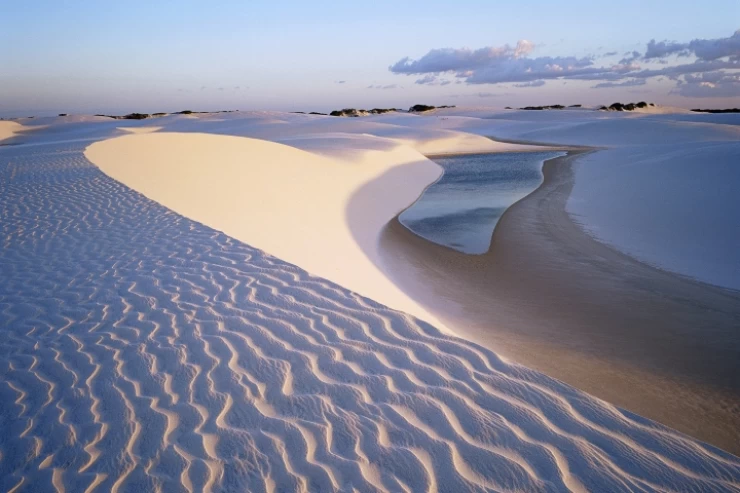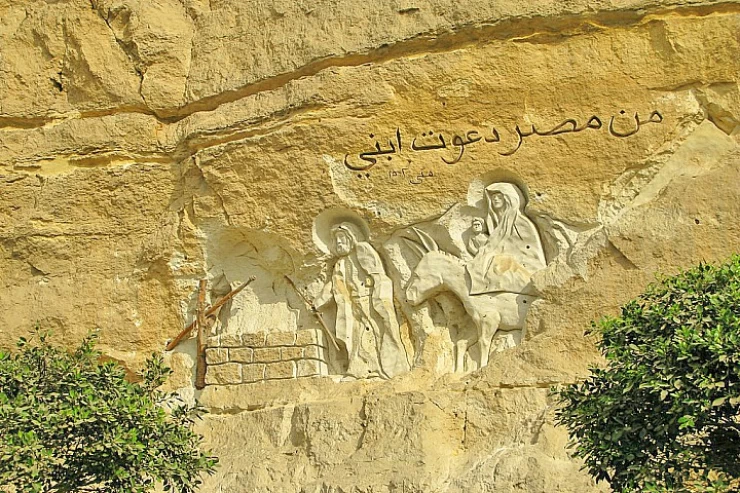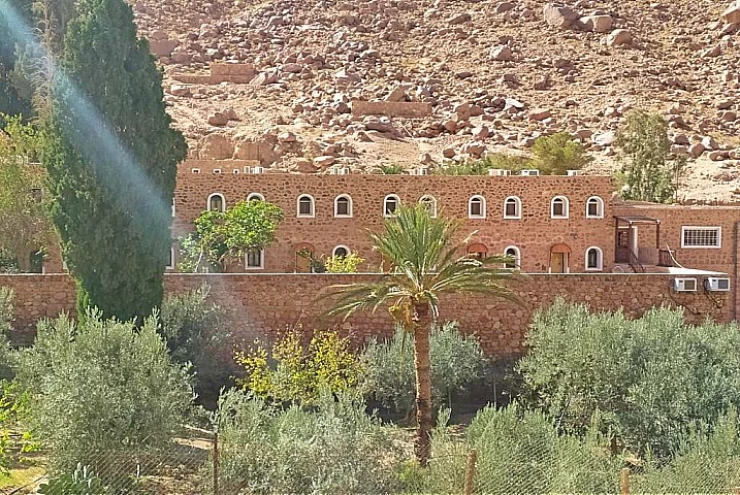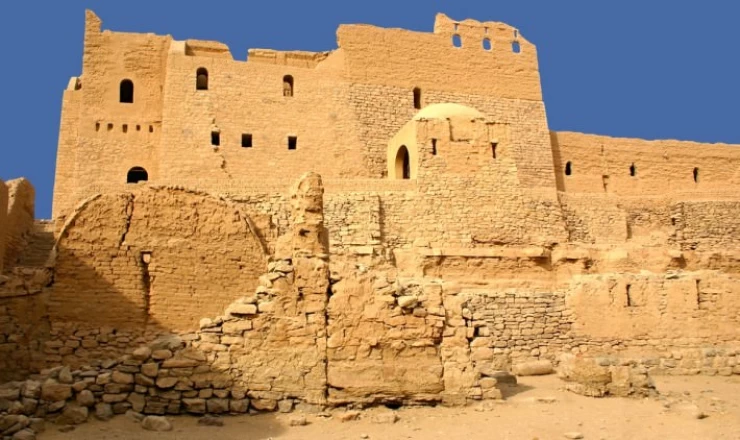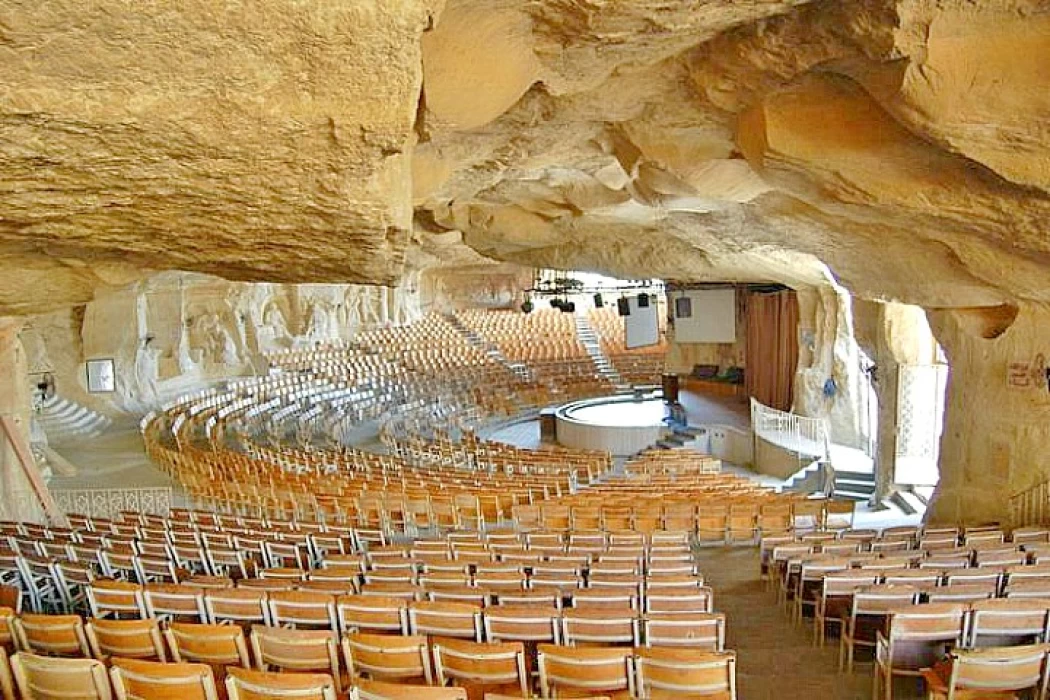
Monastère de Saint Simon Le Tanner
Monastère de Saint Simon Le Tanner
L'église est l'un des plus rares chefs-d'œuvre architecturaux sculptés au cœur du mont Mokattam, car elle allie la beauté de la nature à une architecture originale. Elle est devenue une attraction touristique majeure car elle est la plus grande d'Égypte, avec une capacité de 20 000 personnes, et compte 76 images enregistrées. Une fois que vous entrez dans la montagne de Mokattam et que vous vous approchez de la région d'Abagya, vos yeux vous mèneront vers l'un des artefacts architecturaux les plus rares sculptés au cœur de la montagne Mokattam et l'un des signes créatifs de la montagne. La haute montagne pour se fondre dans l'architecture distinctive dans laquelle le monastère a été construit, et est devenue un site de visite du monde par un grand nombre de touristes du monde entier.
Saint Simon le Tanner était un artisan qui a vécu au 10ème siècle et son monastère est considéré comme l'une des choses à faire au Caire. Mais il n'est généralement pas visité pendant les itinéraires de courte durée et les excursions d'une journée au Caire, et l'église rupestre qui était qui lui est dédié pourrait ne pas durer 10 de plus. L'utilisation d'une grotte préexistante et de la pente qui menait au monastère peut accueillir 20 000 personnes autour d'une chaire centrale. Diverses grottes ont également été formées en espaces d'églises séparés, et toutes ont été liées pour créer un immense complexe chrétien au cœur de la ville des ordures. Des centaines de milliers de personnes font le pèlerinage chaque année au monastère. Des centaines de milliers de personnes font le pèlerinage chaque année au monastère. L'église principale porte le nom de la Vierge Marie et de Saint-Simon en commémoration de l'histoire de l'ouverture de la montagne Mokattam en novembre 979, lorsque Simon le Tanner a été choisi pour accomplir ce miracle. La montagne Mokattam fait face à la Citadelle de Saladin.
Selon les historiens, Ya’qub ibn Kulas, d’origine juive, le ministre du calife al-Mu’izz Ledin Ellah, était farouchement anti-chrétien, et le calife était un homme de savoir et de littérature. Ce dernier a invité le patriarche des Coptes à discuter des Juifs en matière de religion en sa présence, et le patriarche a répondu à l'invitation, accompagné de Mgr Sawyros Ibn Al-Maqfa. Au cours de la discussion, Sawyerus a accusé les Juifs d'ignorance, citant un verset du livre d'Isaïe qui dit: "Le taureau connaît sa canne, et l'âne est le propriétaire de son propriétaire. Israël ne sait pas! Mon peuple ne comprend pas! " (Esaïe 1: 3). Cela a déclenché la colère d'Ibn Kallas, qui a décidé avec l'un de ses compagnons de répondre aux chrétiens en chassant un trou dans leurs livres, et sa recherche a conclu un verset du Nouveau Testament dans lequel le Christ s'adresse à ses disciples: «Si vous aviez la foi comme un grain de moutarde, diriez-vous à cette montagne va d'ici à là Alors ça bouge, et rien n'est possible pour toi "(Matt 20:17).
Le ministre a présenté ce verset au calife et lui a demandé d'obliger les chrétiens à prouver la prétention de leur livre. Cela a fait appel au calife, qui voulait se débarrasser de la montagne à l'est du Caire. D'un autre côté, si les chrétiens éludaient l'accomplissement du verset évangélique, ce serait la preuve de l'invalidité de leur religion et de leurs croyances. Al-Moez a envoyé le patriarche pour l'informer de sa demande, le menaçant s'il échouait avec des conséquences graves et lui donnant trois jours pour mettre en œuvre cela. Toute l'église du pays pendant cette période a jeûné et prié.
La narration religieuse complète l'histoire, parlant de l'apparition de la Vierge Marie sur le patriarche le troisième matin. Je lui ai dit de sortir pour voir un homme portant une jarre d'eau, qui serait l'élu pour accomplir le miracle sur ses mains. Après avoir exécuté le commandement de la Vierge, Simon a trouvé le Kharaz et lui a raconté ce qui s'était passé. Quant à ce dernier, il a demandé au patriarche de rester parmi le peuple le jour prévu pour déplacer la montagne et de là il effectuerait la prière tandis que le patriarche dessinerait le signe de la croix. Cela a été fait, a-t-il dit, lorsqu'un grand tremblement de terre s'est produit et que la montagne s'est déplacée jusqu'à ce que le soleil halète sous elle. Après cela, Al-Kharaz s'est échappé afin que personne ne puisse être félicité.
Sur 2 étages ont été construits la Vierge Marie et la cathédrale St Simon d'abord, ce n'était qu'une immense grotte de calcaire dans la montagne. La 2ème étape a eu lieu en novembre 1994 et a lieu lors de la fête de la Saint-Simon. Des sièges fixes ont été construits autour de l'autel sous la forme d'un auditorium en quart de cercle pour accueillir jusqu'à cinq mille personnes et c'est pourquoi elle est devenue la plus grande église du monastère. Une autre église étonnante du monastère est l'église St Bola, du nom de St Bola, le premier pèlerin pour les vertus qu'il possédait. Il a vécu dans des grottes et dans la solitude pendant 70 ans au cours desquels il n'a jamais posé les yeux sur un visage humain.
La grotte de la chapelle a été découverte en 1986 lors de travaux de construction lorsqu'un énorme rocher est tombé montrant une ouverture dans le plafond de la grotte. Une histoire intéressante sur cette église a eu lieu en janvier 1992 lorsqu'elle a été mise en danger par un incendie causé par une étincelle électrique. L'image de Jésus-Christ s'étendant dans l'église et l'autel n'a pas été endommagée, même si tout l'intérieur de la grotte a été endommagé.
Vous pouvez découvrir de nombreuses choses intéressantes sur un bâtiment spécial appelé Palais du Baron Empain. Il est situé dans une grande ville appelée Le Caire, qui se trouve dans un pays appelé Égypte.
A Hidden Gem in Cairo's Mokattam Hills .One of the most remarkable and beautiful historical places of worship is the Monastery of Saint Simon the Tanner, also known as the Cave Church, situated in the hilly, rocky Mokattam Hills of Cairo. Unlike the busy and crowded capital city of Egypt, this beautiful monastery does not only serve as a tranquil sacred space open to those who come in to seek the presence of God but rather possesses an exceptional view of walls sculpted into rocks forming the structure of the church. The very history of the place is almost more than ancient Coptic Christianity and the miraculous. For this reason, no matter how much in a hurry one is, a visit to this place is worth it for every religious lover wanting to explore Egypt’s religious mosaic.
The monastery is named after Saint Simon the Tanner, a Coptic saint from the 10th century who is most celebrated for a miracle during the rule of the Fatimid Caliph Al-Muizz. As per the Coptic tradition, it is said that during one of the reigns of the Copts, Al Muiz introduced a challenge to Pope Abram, the most senior leader of the Coptic Orthodoxy, to shift the Mokkatam mountain to illustrate that Christianity is true. After three days spent in prayers and fasting, Pope Abram had a vision of the virgin Mary, who asked him to look for Simon the Tanner. Simon, a simple leather craftsman who was very well connected with God, when the church gathered to pray, the mountain in question was raised, thus demonstrating the Christian religion to Al Muiz.
As a remembrance of this miracle, many centuries later, the large monastery compound in Mokattam was built in recognition of Saint Simon and the important event. At present, the monastery is also a monument to the Christian history of Egypt and the Christian context of the country.
The Monastery of Saint Simon the Tanner, which is located in the city of Cairo, is paradoxically quite remote. This monastery is located within Mokattam’s garbage city, wherein the Zabbaleen, are informal garbage cleaners of the city. The monastery, however, remains an island of peace amidst the turmoil. While the path to the monastery weaves through several narrow, twisting cores and squat buildings teeming with the city’s recycling activity, the view of the Cave Church’s gigantic rock-hewn altar is simply astounding.
The Monastery of Saint Simon the Tanner encloses an ensemble of several churches, each of exceptional interest: The most well-known and the one that leaves the greatest impression is The Cave Church, or, as it is more often referred to, The Church of Saint Simon the Tanner. This colossal area is hewn from the mountainside, making it the biggest church in the entire Middle East that can hold about 20,000 people. The inside of the cave is filled with religious images, paintings, and sculptures from the Holy Bible and the life of Saint Simon, which is all aglow with bright light coming from the rock ceilings. Above the cave, there are numerous cracks through which come rays of sunlight.
Within the compound, there are other notable churches such as:
The Church of Saint Mark: A compact but equally attractive church boasting soft stone carvings and quiet, contemplative areas for prayer and meditation.
The Church of Saint Bola: This church is also hewn from the rock and is cherished by tourists for its calm and peaceful interiors.
The Church of the Virgin Mary and St. Simon the Tanner: A congregation of faithful at a smaller church, where the churchgoers convene for daily masses and spiritual services.
Every church embodies a different spirit and embraces the beauty of nature along with the depth of spiritual culture.
The architecture of the Monastery of Saint Simon the Tanner is one of its most breathtaking features. The churches and spaces are not built conventionally but are hewed out of the rock of the Mokattam Hills. The use of natural, unprocessed limestone as the wall surfaces creates a rugged environment for the interior, allowing the guests to truly appreciate the ancient history of this place. This style of building also plays a part in enhancing the quality acoustic properties of the monastery, enabling the beautiful resonation of the Coptic liturgical hymns and chants all around the huge cave.
The outside view of the church complex is also exceptional. The corrugated grounds at the periphery of the monastery are embellished with high-relief sculptures and carvings that illustrate Biblical and Coptic cultural incidents. These high-stand carvings were done by a Polish sculptor, invariably hierarchy, thereby elevating the station of the site.
The Zabbaleen Connection
Over the last century, the Zabbaleen, a well-organized group of waste collectors or garbage collectors inhabiting the Mokattam region of Cairo, have had a very positive interaction with the Monastery of Saint Simon the Tanner. Most of the Zabbaleen are Copts, and like most communities in Egypt, they have suffered from troubles both social and economic. Nevertheless, a considerable part of this population has thrived in Garbage City through better integration of waste management and environmental services.
Though the purpose of the monastery transcends the physical boundary of the monastery, containing the Zabbaleen as it is, the monastery also offers hope and faith to these people. Some of the Zabbaleen assist in maintaining the monastery, and the place is important in their routine activity as a prayer and a meeting place. In addition to the monastery of Saint Simon the Tanner, a visit to the Zabbaleen's settlement reveals the extent to which their relentless work in recycling waste in Cairo went.
Religious significance and pilgrimage
The Monastery of Saint Simon the Tanner is a well-known place of pilgrimage for Coptic Christians not only in Egypt but also throughout the world. Many pilgrims primarily come to pray and meditate on the life and miracles of St. Simon. They seek inner healing and divine connection. The church also conducts regular services such as mass and other religious activities besides of the memorial services for Saint Simon, who is remembered annually on the 26th day of November.







